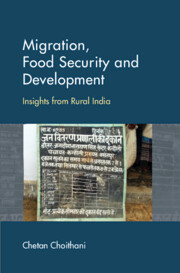Book contents
- Frontmatter
- Contents
- List of Figures, Tables and Boxes
- List of Photos
- Preface
- Acknowledgements
- List of Abbreviations
- 1 Introduction
- 2 Bridging the Disconnect between Migration and Food Security
- 3 Dynamics of Food Insecurity, Migration and Urbanisation in India
- 4 The Context of Migration
- 5 Connections between Food Safety Nets and Migration
- 6 Migration, Remittances, Land and Household Food Security
- 7 Opening the Household Box
- 8 Conclusion
- References
- Index
3 - Dynamics of Food Insecurity, Migration and Urbanisation in India
Published online by Cambridge University Press: 22 February 2023
- Frontmatter
- Contents
- List of Figures, Tables and Boxes
- List of Photos
- Preface
- Acknowledgements
- List of Abbreviations
- 1 Introduction
- 2 Bridging the Disconnect between Migration and Food Security
- 3 Dynamics of Food Insecurity, Migration and Urbanisation in India
- 4 The Context of Migration
- 5 Connections between Food Safety Nets and Migration
- 6 Migration, Remittances, Land and Household Food Security
- 7 Opening the Household Box
- 8 Conclusion
- References
- Index
Summary
INTRODUCTION
At the global level, India has more undernourished people than any other country in the world. During 2017–19, the most recent period for which comparable cross-country data are available, the number of chronically undernourished people in India was estimated to be 189 million. To put this figure in perspective, the absolute number of people suffering from undernourishment in India is only slightly lower than the number of undernourished people in 48 countries of Sub-Saharan Africa combined. Seen in percentage terms, this figure is equivalent to over a quarter of the world's undernourished people, and it represents almost half of the total burden of undernourishment of the whole of Asia and nearly 75 per cent of the South Asian region (FAO et al., 2020). Furthermore, a trend analysis of undernourishment reveals that during 1990–92 – the baseline period used by the FAO in order to track the progress of the countries on the World Food Summit, 1996, and the MDG target on hunger and undernourishment – India's neighbouring countries in South and Southeast Asia, including Bangladesh, Cambodia, Laos, Myanmar, Thailand and Vietnam, had a higher percentage of their population who suffered from hunger. Yet these countries achieved the MDG target of halving the proportion of undernourished people by 2015, while India slid off the track (FAO, IFAD and WFP, 2015, p. 46). This is despite the fact that the Indian economy performed much better than most of these countries in this period. The post-2015 SDGs agenda envisages eliminating undernourishment completely from the planet (United Nations, 2015). The sheer magnitude of the number of undernourished people in India suggests the wider significance of the country from the perspective of global progress on hunger reduction.
The aggregate figure on the number of undernourished people, however, conceals several regional and social aspects of the problem. In India, the prevalence of undernourishment varies significantly across different states and rural–urban areas within the states. Furthermore, there are marked asymmetries in the levels of undernourishment among different social groups, with Scheduled Castes and Scheduled Tribes faring the worst on this front. Indeed, although India has been fairly successful in averting the large-scale recurring famines of the past in the post-independence era, incidences of deaths due to starvation and child malnutrition among the lower caste and tribal communities continue to be reported (Jha, 2002; Mander, 2012; Parulkar, 2012; Patel, 2018) even in the more developed states such as Kerala (Manikandan, 2014). Additionally, and this is an important point to emphasise, the persistence of widespread gender inequalities in many parts of India means that women and girls are more prone to hunger and undernourishment as compared to their male counterparts. This has severe implications from the perspective of intergenerational transfers of health and nutrition outcomes, as children born to ill-nourished mothers are more likely to be malnourished.
- Type
- Chapter
- Information
- Migration, Food Security and DevelopmentInsights from Rural India, pp. 63 - 97Publisher: Cambridge University PressPrint publication year: 2023



